How Tianli Zu’s Archibald ‘gift’ emerged from summer’s tragic flames
Destruction and devastation brought artist and Archibald Prize finalist Tianli Zu to the subject of her most important work yet.
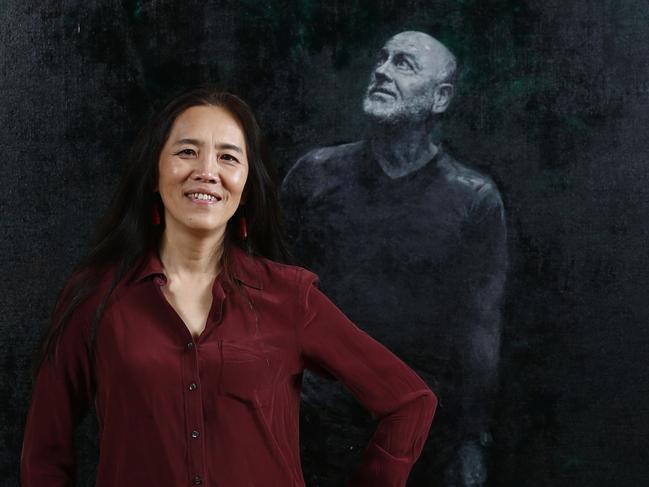
North Shore
Don't miss out on the headlines from North Shore. Followed categories will be added to My News.
- How Dee Smart developed a ‘superpower’ during cancer
- North Shore, Mosman’s best hairdressers revealed
In January 2020 artist Tianli Zu was hosting creative workshops in the sleepy village of Mittagong, in country New South Wales. The workshops were for experienced painters looking to broaden their skills and enhance their creative techniques under the careful tutelage of Zu, a classically-trained and much admired artist from St Ives.
The students were delighted to be working with an artist of such calibre, but the atmosphere was tense, says Zu, who noted anxious whisperings of bushfires on the horizon. Within days of the workshop beginning, those fears became a reality when flames of unimaginable ferocity roared into town.
Zu, who was born and raised in Beijing, China, and moved to Australia in 1988, was stricken with fear.
“It was horrifying,” she says today.
“The fires were completely out of control. My students were continuing to come to class each day and reporting back how they had lost everything. Their homes, their land … it was all burning down.
“It was so scary. I would say to them, ‘Why are you still here?’ and they would say there’s nothing we can do … the house is gone, but making art with you … it helps us to feel that we can rebuild, it gives us energy.”
Those words struck Zu deeply. Art helps us to rebuild. She repeated it quietly to herself like a mantra. Right now she has a portrait hanging in the Archibald Prize exhibition in the Gallery of New South Wales after being named a finalist.
Zu is ecstatic about that. But not just for the obvious reasons. And to explain her joy fully we need to jump back to that bushfire experience and what followed.
Zu left Mittagong and returned to the leafy north shore but she kept a close eye on the south coast of the state, concerned for residents, holiday-makers, native animals and the beautiful countryside itself.
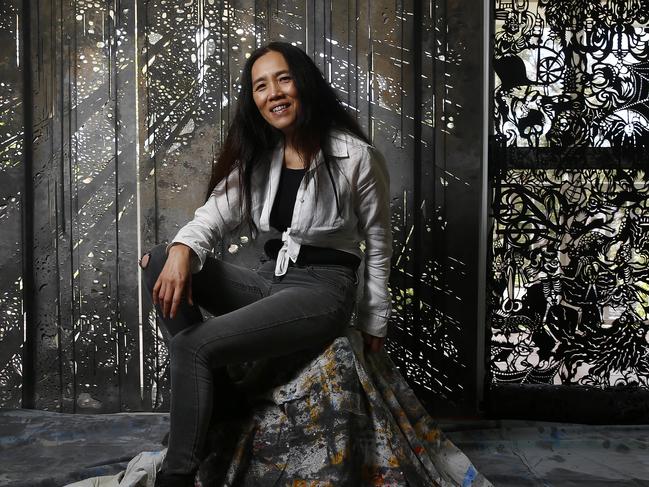
Like so many Australians she pored over the news in a bid to discover why these particular fires had been so devastating. We discovered that 2019 was Australia’s hottest year on record, the annual maximum temperature 1.52C higher than ever before. We also learned that in early January of that year, parts of western Sydney had reached 48.8C degrees. The year 2019 was Australia’s driest year on record – worse, Zu read, it came off the back of 2018, a 12-month period that saw excruciatingly little rain too.
Mittagong was devastated but it was not alone. Throughout the country these particular fires reduced many homes to smoke and rubble, along with historically-important public buildings and shockingly, the lives of 28 people were also lost.
The situation hurt Zu’s heart.
What did boost her spirits was hearing from her students who had lost so much when the fires tore through their town and their lives.
“They kept in touch,” she says softly.
“They would send me pictures … I was very moved.”
The pictures Zu’s students sent were of themselves working on their new houses, smiling broadly with hammers in hand, repairing fences with beloved pets at their ankles, planting saplings alongside family and friends. Everyone was doing their bit. Zu wondered how she could pitch in.
And it was then she thought of environmentalist and conservationist Tim Flannery – a man deeply familiar with our bushfire history. As he wrote in the New York Review in 2020, he knows all too well the devastating effects they can have.
Flannery himself lost a house to bushfire in Sydney in 1994, and in 2002, fought a fierce battle with another just north of the city.
But, he went on to confirm, he had never experienced anything like the fires that tore across our country in the summer of 2019 and 2020 – the ones that saw Zu’s students lose their homes.
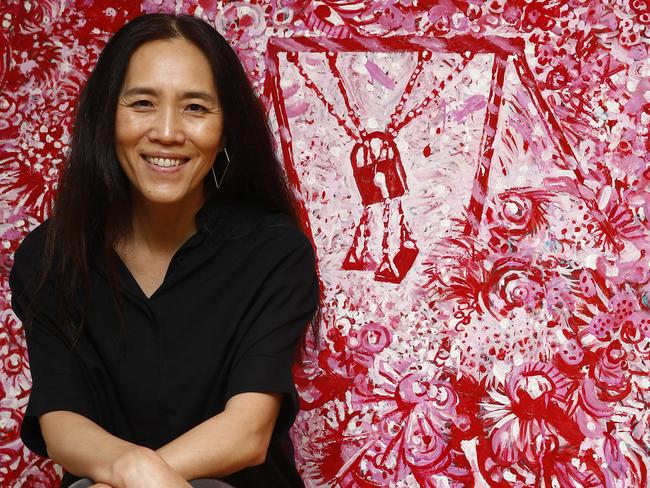
“The fires are like some hidden beast, toying with the fates of entire communities for weeks on end, before pouncing with deadly effect,” wrote Flannery in the article.
“For some, the dread becomes so unbearable that they say they want to ‘bring it on’, just to end the agony of uncertainty and waiting.”
Zu connected instantly with Flannery’s remarks and decided this was how she would help. She would ask Flannery, scientist, activist and one-time Australian of the Year, if he would sit for a portrait – and she would enter that portrait into the Archibald Prize. And that is exactly what she did.
Her startling portrait of Flannery, painted in oil and acrylic on linen, sized 221 by 191cm, was short-listed and is now hanging in the Gallery of New South Wales – a fact Zu is delighted by.
“I had actually been observing him and his work for five years or so after my friend Edmund Capon (art historian and one-time director of the Art Gallery of New South Wales) suggested that I paint him at some point,” explains Zu.
“So I had been reading his books and listening to his talks. I spent years studying him and learning about him and along the way all the aspects of environmentalism and climate change that I didn’t really understand. These are complicated issues, but he made things simple so that people like me could really understand.”
Zu was intrigued by Flannery’s rhetoric about climate change and appreciated he had hope.
“He is positive,” she says.
“He sees solutions … painting a portrait of him is my way of contributing to the issue of climate change. That was and is my motivation.”
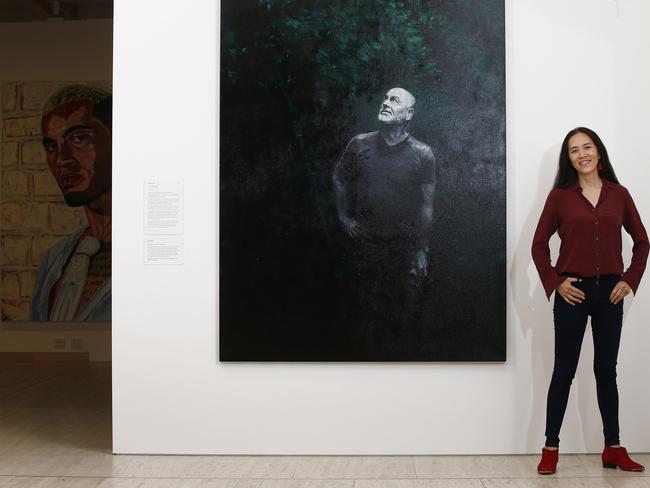
Zu approached Flannery regarding the sitting and he suggested she meet with him at a home in the sleepy coastal village of Austinmer, just 75kms or so north east of Mittagong, where Zu first brushed up against her adopted country’s wildfires.
He asked that she catch the train and she agreed, admiring the wild countryside through the window the entire trip.
On arriving she sketched Flannery in his kitchen while he pottered about. He made her tea, but not before carefully washing the cup, and he read aloud from a recipe book as he gathered ingredients for a meal.
Around his neck, a pair of hi-tech binoculars dangled.
“He’s always paying attention and listening, even when he’s cooking or talking,” says Zu.
“It’s as though he can’t help it. He is a discoverer.”
Every few minutes Flannery would stop stock still, grab his binoculars and stare out the window, generally after hearing an unusual or even unique bird, says Zu. It made capturing his essence somewhat tricky, she adds with a laugh.
“He wasn’t posing for me strictly speaking,” she says.
“But I followed him every where he went. And I tend to draw very quickly. Luckily.”
While he walked, cooked and listened for birds, Flannery talked to Zu about his bold concept of farming kelp in order to draw carbon from the atmosphere and accordingly, limit the impact of climate change.
Kelp, a fast-growing sea algae, could be farmed on a large scale and convert carbon from the air to a non-gaseous form, thus reducing levels of atmospheric carbon, Flannery explained. And Zu was fascinated So much so that she decided to incorporate the concept into her portrait of Flannery.
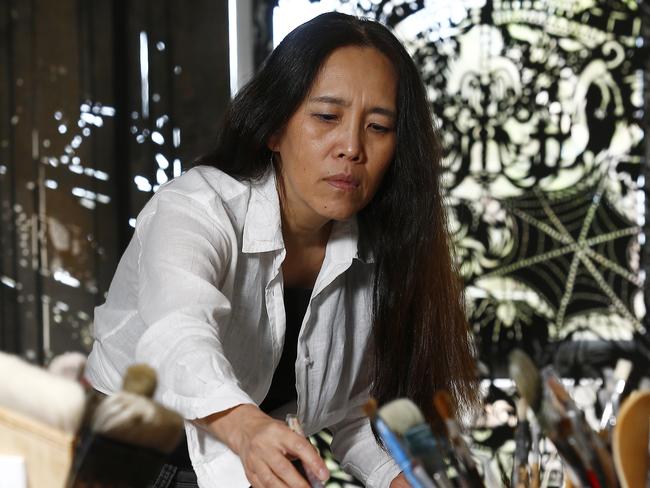
“It took me about six months to complete,” says Zu.
“It was a very long time. I work in a very classical way and normally I wouldn’t paint with strong colours but this painting has about 15 layers of grey and red at its base.”
Those layers of grey and red combine to create a strangely rich and vivid black. This represents the kelp and in the portrait Flannery is emerging from it, like a beacon of hope.
“He’s very positive,” says Zu.
“He agrees the environment is in trouble, that climate change is a grave threat to us all, but he believes it’s a threat we can overcome. I have no real idea how we will do that of course, but I trust him. There is hope and this painting is about sharing that.”
Being short-listed in the Archibald Prize is an honour for any artist. Zu has been short-listed once before but this time is of equal, possibly even greater, importance to her, given the subject of the work and the message she hopes to communicate to as many as possible.
“I asked Tim, ‘How can I help? What can I do?’ And he said ‘You paint this painting. You enter it in the Archibald. That really is the best thing you can do’.”
This is exactly what happened and Zu is thrilled.
“Being included is the perfect way to communicate the urgency of sustainability,” she says.
“It’s the perfect chance to spread the message and it has arrived at a much-needed time. To me it is a gift.”
Finalists in the Archibald, Wynne and Sulman Prizes 2020 are on show at the Art Gallery of NSW until 10 January 2021. For details and tickets, visit artgallery.nsw.gov.au


